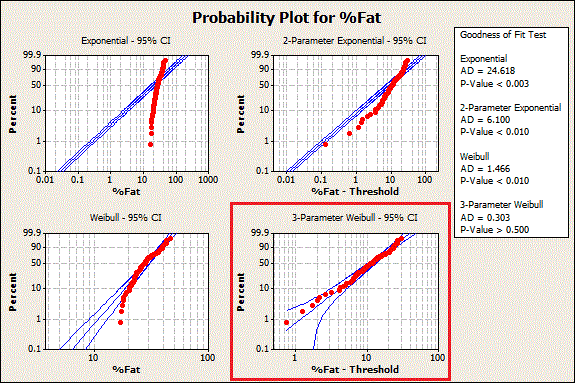

The data values are onthe horizontal axis, the percentile labels (rather than z-values)are on the vertical axis (the spacing is arranged to match equalspacing of z-values).The "percentile" table in the Sessionwindow shows where the percentiles would be if the data were normally distributed (with the same mean and standarddeviation) Select the variable, leave the distribution choiceas "Normal".The graph will print with "confidencebands" around the 45-degree line. Normal probability plots: Use Graph>ProbabilityPlot.

The variableto be plotted goes in Y - so the boxplot will be drawn vertically.If several side-by-side boxplots (for categories) are desired,the values must be stacked in one column, with a second columncontaining an index identifying the category from which each valuecomes. Any options you set will remain inplace for your session (until you Exit Minitab) unless youchange them.īoxplots: Use Graph>Boxplot. The number of classes or the values for eitherthe midpoints or the cutpoints. Whether the bars arelabeled by the class midpoints or cutpoints (classlimits) 3. the type of histogram (frequency,relative frequency, cumulative, etc.) 2. The Annotationbutton will let you write a title for your histogram. Select thevariable(s) by double-clicking in the list. For information on saving the results, see VI.Saving and printing your work A: The graphs you may want You can also get somewhat clunkygraphs drawn in the Session window (so they print with the sessionwindow) using the Character graphs commands (There is a Character graphs submenu at the bottom of the Graphmenu). Minitab produces two general types of graphs: the standardgraphing commands produce High resolution graphs whichuse graphics drawing methods and appear in special graph windows(but are not attached to the session file - so they have to besaved and printed separately). Minitab does not appear to have a way to use the "ones" trick to calculate a prediction interval for a univariate mean.Minitab:Graphs Introduction to MINITAB in the Saint Mary's MicrocomputerLab IV.Perform a t-test for a population mean µ.Calculate a t-interval for a population mean μ.For example, typing "2" will result in an area under the curve of 0.977250 to the left of 2 (corresponding to an upper-tail area of 0.02275). To calculate upper tail areas (p-values) for a standard normal distribution, select Calc > Probability Distributions > Normal, select "Cumulative probability," select "Input constant," and type an appropriate z-value into the "Input constant" box.To create a QQ-plot (quantile-quantile or normal probability plot), select Graph > Probability Plot, choose "Simple," and move "Price" into the "Graph variables" box.For example, typing "0.9" will result in the 90th percentile (corresponding to an upper-tail area of 0.1). To calculate percentiles (critical values) for a standard normal distribution, select Calc > Probability Distributions > Normal, select "Inverse cumulative probability," select "Input constant," and type an appropriate probability into the "Input constant" box.Determine summary statistics for a variable.To create a histogram, select Graph > Histogram, choose "Simple," and move "Price" into the "Graph variables" box.To create a stem-and-leaf plot, select Graph > Stem-and-Leaf and move "Price" into the "Graph variables" box.To load the house prices data, select File > Open Worksheet.


 0 kommentar(er)
0 kommentar(er)
